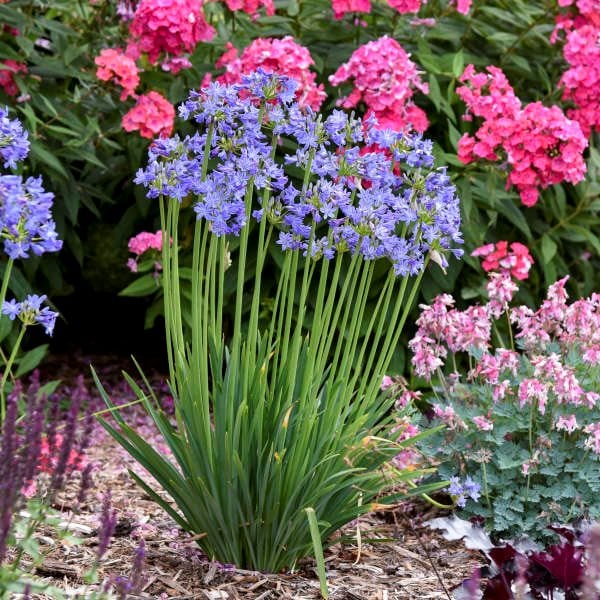Just how to Plant and Maintain Agapanthus in Your Yard
Understanding the Art of Agapanthus Care: Important Actions for Healthy And Balanced Development and Vivid Blooms
In the realm of horticulture, the cultivation of agapanthus stands as a satisfying undertaking for those that seek to support these sophisticated blooming plants. With their striking blossoms and graceful foliage, agapanthus has caught the interest of gardeners worldwide. Nevertheless, attaining optimum development and lively blooms calls for a nuanced approach that encompasses various crucial steps. From choosing the best range to grasping pruning strategies, the trip towards growing flourishing agapanthus plants is complex and holds the vital to opening the complete capacity of these agricultural treasures.

Choosing the Right Agapanthus Variety

When picking the ideal Agapanthus variety for your yard, take into consideration aspects such as climate viability, blossom shade, and development routine. In addition, think about the climate in your region to ensure the Agapanthus selection you pick can flourish in your specific conditions. Comprehending the growth practice of different Agapanthus selections is essential for proper placement within your yard.
Ideal Planting Conditions
Considering the optimal environmental demands is necessary for successful Agapanthus growing. Agapanthus plants are sensitive to chilly temperature levels and ought to be secured from frost throughout winter season months.
To make sure healthy growth and vibrant flowers, plant Agapanthus bulbs at a deepness of concerning 2-4 inches and space them 8-12 inches apart. Adding raw material, such as garden compost, to the soil can improve drain and fertility, advertising durable root development. Mulching around the base of the plants aids preserve wetness and reduces weed development. Normal watering is crucial, especially during the expanding season, to maintain the dirt constantly moist yet not soaked.
Watering and Feeding Tips
Maintaining correct moisture degrees and supplying essential nutrients are crucial elements in the treatment regimen for Agapanthus plants. It is vital to strike a balance when it comes to sprinkling Agapanthus. If overwatered, these plants prefer regularly wet dirt but are vulnerable to root rot. Throughout the expanding season, water deeply once a week, making sure the soil is well-draining to avoid waterlogging. In hotter environments or throughout periods of drought, even more regular watering might be needed to keep the dirt uniformly moist. Nevertheless, minimize watering in the winter season to avoid waterlogged conditions.
Feeding Agapanthus is crucial for advertising healthy and balanced development and respected blooms. Use a balanced plant food, such as a 10-10-10 formula, in the early spring as brand-new development arises. Repeat this application every 6-8 weeks throughout the expanding season. Prevent too much fertilization, as it can result in rich foliage at the cost of flowers. Constantly adhere to the manufacturer's directions for correct dilution and application approaches. By adhering to these watering and feeding tips, you can guarantee your Agapanthus plants thrive and generate dynamic, lasting blossoms.
Trimming Techniques for Agapanthus
Pruning Agapanthus plants at the proper times and with appropriate techniques is critical for keeping their health and promoting optimum development and flowering. The suitable time to prune Agapanthus remains in late winter or very early springtime prior to new growth arises. Beginning by removing any dead or yellowing fallen leaves near the base of the plant. Cut them as important site close to the ground as possible without harming the arising shoots.
Deadheading invested flowers can likewise reroute the plant's power into producing even more blossoms rather than establishing seeds. If you want to collect seeds for breeding, leave some blossoms to dry and mature on the plant.
Keep in mind to use tidy, sharp devices to make exact cuts and reduce the threat of introducing illness. Agapanthus. Normal trimming will aid keep your Agapanthus looking healthy and neat while ensuring an abundant display of gorgeous flowers
Managing Usual Pests and Diseases
After making certain appropriate trimming strategies for Agapanthus, it is important to attend to common insects and illness that can influence the health and wellness and vigor of these plants. Agapanthus plants are generally durable yet can still succumb particular concerns. One typical bug that affects Agapanthus is the Agapanthus gall midget. This small, orange fly lays its eggs in the vegetation, bring about altered development and flower buds that stop working to open up. To battle this bug, prune and destroy any type of damaged plant parts and consider making use of insecticidal soap.
An additional common concern is fungal fallen leave spot, which provides as dark lesions on the leaves. To avoid fungal conditions, make certain excellent air blood circulation around the plants, avoid overhead watering, and get rid of any type of contaminated leaves promptly. Additionally, Agapanthus plants can deal with root rot if they are grown in badly draining pipes dirt. To avoid this, plant Agapanthus in well-draining dirt and prevent overwatering. By being alert and taking prompt action against illness and bugs, you can help your Agapanthus plants grow and create vibrant blooms.

Final Thought
In verdict, mastering the art of agapanthus care entails picking the appropriate variety, offering optimal growing conditions, correct watering and feeding, appropriate pruning strategies, and dealing with common parasites and illness. By following these important actions, you can ensure healthy and balanced development and dynamic flowers for your agapanthus plants. Keep in mind to regularly keep an read this post here eye on and keep your plants to promote their overall well-being and durability.
To make sure healthy and balanced growth and reference dynamic flowers, plant Agapanthus bulbs at a deepness of about 2-4 inches and room them 8-12 inches apart. By complying with these watering and feeding ideas, you can ensure your Agapanthus plants prosper and generate vibrant, resilient blossoms.
One common bug that affects Agapanthus is the Agapanthus gall midget. In addition, Agapanthus plants can endure from root rot if they are grown in inadequately draining pipes dirt. By following these necessary steps, you can make certain healthy and balanced growth and lively flowers for your agapanthus plants.